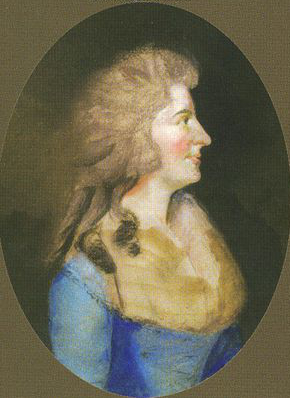Sophia Dussek facts for kids
Sophia Giustina Dussek (born Corri, later known as Moralt; Edinburgh, 1 May 1775 – London, around 1831) was a talented Scottish singer, pianist, harpist, and composer. She had Italian family roots.
In 1792, Sophia married the famous composer Jan Ladislav Dussek. After Jan passed away in 1812, Sophia married violist John Alvis Moralt. They lived in Paddington, London, where Sophia started her own music school.
Sophia's music was very popular. Her Op. 2 sonatas were published many times in the 1790s. These six sonatas, including a well-known one in C minor, were definitely Sophia's work. Some later editions mistakenly said they were by Jan Ladislav Dussek, but this was not true. People only started thinking this in the mid-1900s.
Contents
Sophia Dussek's Early Life and Family
Sophia Dussek was born into the Corri family, a musical family. She learned to sing from her father, Domenico Corri. He was a composer, music publisher, and also organized concerts. Her uncle, Natale Corri, was also a composer. Her cousin, Fanny Corri-Paltoni, was a soprano singer.
Sophia's father made sure she started performing at a young age. She became well known as a soprano singer and also wrote many songs.
Sophia's Musical Training and Performances
In 1788, Sophia moved to London. There, she continued her music studies with Luigi Marchesi and Giovanni Battista Cimador. Sophia was a very skilled performer. She made her London debut in 1791 at the important Salomon concerts. The famous composer Haydn was even directing from the harpsichord.
After her debut, Sophia sang in many of these concert series. She was part of the first performance of Haydn’s piece called The Storm. In 1792, she sang the main role in the first performance of Harriet Wainwright's opera Comala.
Sophia also helped introduce the music of Mozart to London. She was a solo singer in the first London performance of Mozart's Requiem. This concert took place on February 20, 1801, at Covent Garden.
In 1792, she married Jan Ladislav Dussek. They had been performing together for some time, with Sophia singing and playing the piano and harp. Their daughter, Olivia, also grew up to be a pianist, harpist, and composer.
Later Life and New Beginnings
After Jan Ladislav Dussek passed away in 1812, Sophia was able to remarry. She married viola player John Alvis Moralt. They lived in Paddington, a part of London. There, Sophia started her own music school. She continued to publish many musical pieces. These included sonatas, rondos, variations, and arrangements for the piano or harp.
Sophia Dussek's Compositions
Sophia Dussek wrote many pieces for different instruments.
Keyboard Music
- Sonata for piano (or harpsichord) with violin or flute, Op. 1 (published in London around 1793)
- 3 Sonatas for harpsichord (or piano) with violin, Op. 1 (published in Paris)
- Sonata for piano (published in London around 1805)
Harp Music
- 3 Sonatas with Scots Airs and Reels for the Adagios & Rondos, Op. 2 (Book I): B-flat, G, C minor (published in London, 1794)
- 3 Sonatas with Scots Airs and Reels for the Adagios & Rondos, Op. 2 (Book II): E-flat, F, C (published in London, 1795)
- 6 Sonatas (Sonatinas): C, F, G, B-flat, F, E (published in London, 1799). These were once thought to be by Jan Ladislav Dussek.
- A French air with variations (published in London, 1820)
- "C’est l’amour": A 3rd French air with variations (published in London, 1820)
- Introduction and March (published in London, 1822)
- Variations on God Save the King (published in London, 1822)
- "La Chasse": An original rondo (published in London, 1824)
- At least 7 sets of Favorite Airs (published in London), some could be played with flute or violin.
- Many arrangements of other music.
Music for Harp and Piano
- Duett (published in London, around 1812)
- Introduction and Waltz (published in London, 1822)
- Various arrangements.
See also
 In Spanish: Sophia Dussek para niños
In Spanish: Sophia Dussek para niños


